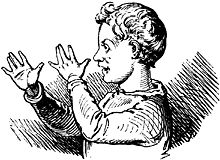Long nose


The long nose is understood throughout Europe gesture that ridicule or scorn expresses. You raise a spread hand to your head, bring your thumb to the tip of your nose and point your little finger at the person being mocked. The insult is often accentuated with sticking out the tongue or screams like "ätsch, bätsch". The expression "turn a (long) nose at someone" in the sense of "mock" or "trick" also relates to this gesture .
origin
With the gesture is subordinated to the offended counterpart in the very real sense of the word, a long, face disfiguring nose to have. In the late Middle Ages, long noses were an attribute of fools , similar to the red cardboard nose of clowns today . From Sebastian Brant's Ship of Fools (1494) shows that fools wore a long nose of wax dummy. The phrase “having a waxy nose” or “turning someone's waxy nose” in the sense of “fooling someone” refers to this. With the nasal pull, there is still a custom today in Wolfacher Carnival in the Black Forest , in which only men with as originally designed noses as possible go through the city on Shrove Tuesday. It is related to the idea, which is particularly well known today from Carlo Collodi 's children's book Pinocchio (1881/1883), that the nose grows a little with every lie uttered .
The oldest pictorial representation of the gesture is found in an etching by Pieter Bruegel the Elder , The Feast of Fools from 1559. An even older literary testimony can be found in the nineteenth chapter of the second book of François Rabelais ' Gargantua und Pantagruel (1534), in the Panurge with the Englishman Thaumast holds a theological-philosophical disputation in front of the scholars of the Sorbonne , in which, however, only the means of pantomime are permitted, so that the meaning of Panurge's gesture cannot be determined unequivocally:
Panurge immediately lifted his right hand, put the thumb of this hand into the right nostril, while he held the other four fingers stretched and joined together parallel to the nasal ridge, pinched his left eye and peeked with his right eyebrow Lid pressed down. "
In the meantime, the gesture seems to have fallen out of use in parts of Europe, but reappeared in the 18th and 19th centuries. At that time it was apparently also understood as a parody of military greetings , comparable to the fool's calls and greetings of the Rhenish carnival , which often imitate military, courtly and church rituals. At least in the English and American literature of the early 19th century it is more often described as a novel curiosity; it competed different names such as Queen Ann's Fan ( "The subjects of the Queen Anne"), (to) cock a snook and the Shanghai gesture ( "The Shanghai Gesture," according to the similarity with the shanghai designated slingshot ), the most common today Designation is to thumb one's nose .
In French , the idioms avoir un pied de nez (“embarrassing yourself when doing a project”, literally “having a nose a foot long”) and faire un pied de nez (“a long nose ”) have been used in any case since the 17th century make, mock "). Victor Hugo (in Les Misérables , 1862) and Alfred Delvau (1866) described the accompanying gesture as typical of the bad behavior of Parisian gutter boys. In Italian the gesture is known as marameo , which originally referred to a harlequin figure from the Commedia dell'arte of the Renaissance period.
literature
- Archer Taylor : The Shanghai Gesture (= Folklore Fellows' Communications 166). Suomalainen Tiedeakatemia (Academia Scientiarum Fennica), Helsinki 1956.
Web links
Individual evidence
- ↑ Desmond Morris : Body Talk: A World Guide to Gestures . Jonathan Cape, London 1994, pp. 180-181.
- ↑ nose, f. in the German dictionary by Jacob and Wilhelm Grimm.
- ^ François Rabelais: Gargantua and Pantagruel . Translated by Walter Widmer and Karl August Horst. Rütten & Loening, Berlin 1970, Volume I, p. 425.
- ↑ Lutz Röhrich : Lexicon of the proverbial sayings . Herder, Freiburg 1973, Volume 2, p. 675.
- ↑ Desmond Morris : Body Talk: A World Guide to Gestures . Jonathan Cape, London 1994, pp. 180-181.
- ↑ Dictionnaire de l'Académie française , 5th edition, Paris 1811, p. 160: “On dit proverbialement que Quelqu'un a un pied de nez , pour dire qu'il a eu la honte de n'avoir pas réussi dans ce qu'il voulait, et Qu'on lui a fait un pied de nez , pour dire qu'on s'est moqué de lui. "
- ^ Victor Hugo: Les Misérables . 10 volumes. Pagnerre, Paris 1862, here Volume III.1, p. 35: “Le gamin aime le hourvari. Un certain état violent lui plaît. Il exècre "les curés". Un jour, rue de l'Université, un de ces jeunes drôles faisait un pied de nez à la porte cochère du numéro 69. - Pourquoi fais-tu cela à cette porte? lui demanda un passant. L'enfant répondit: Il ya là un curé. "
- ^ Alfred Delvau: Dictionnaire de la langue verte. Argots parisiens comparés . 2nd Edition. E. Dentu, Paris 1866, p. 369.
- ↑ Giancarlo De Cataldo : Il perché del Marameo ( Memento of the original dated February 23, 2015 in the Internet Archive ) Info: The archive link was inserted automatically and has not yet been checked. Please check the original and archive link according to the instructions and then remove this notice. , in: L'Unità (online edition), April 13, 2010.
